It is Important to Secure and Monitor your Cannabis
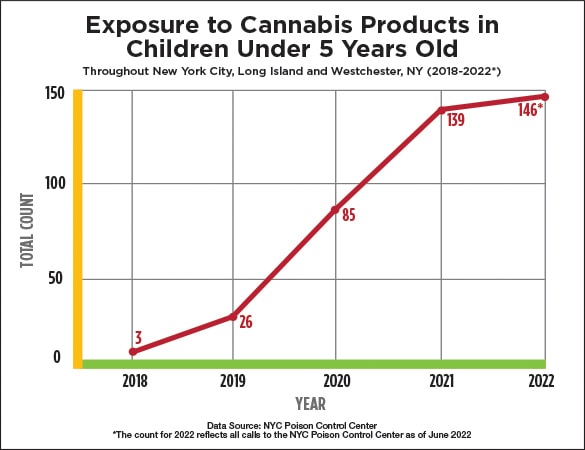
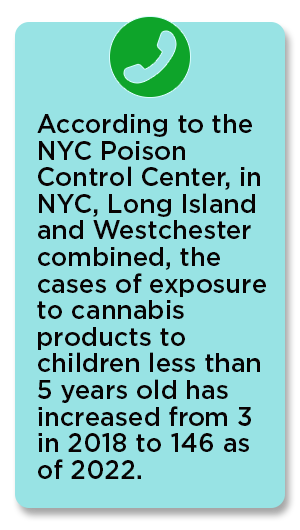 According to the New York City Poison Control Center, in NYC, Long Island and Westchester combined, the cases of exposure to cannabis products to children less than 5 years old has increased from 3 in 2018 to 146 as of 2022.3 Accidentally consuming edibles is a risk for children and pets that can result in cannabis toxicity or the need for emergency medical attention.2 Children may become very sick and have difficulty sitting up, standing or breathing.4
According to the New York City Poison Control Center, in NYC, Long Island and Westchester combined, the cases of exposure to cannabis products to children less than 5 years old has increased from 3 in 2018 to 146 as of 2022.3 Accidentally consuming edibles is a risk for children and pets that can result in cannabis toxicity or the need for emergency medical attention.2 Children may become very sick and have difficulty sitting up, standing or breathing.4
If a child has had accidental exposure to cannabis or cannabis products of any kind, call the Poison Control Center at (800) 222-1222 or visit your local emergency room. Contact your vet immediately if your pet has ingested a cannabis-containing product.
Health Impact on Youth and Young Adults
Certain compounds in cannabis like THC can affect the brain in ways that can impact behavior, mood, thoughts or perceptions, and can be intoxicating.2 It is important to recognize that intoxication can be felt differently in different people and depends on the type of cannabis product being consumed, how much is being consumed and whether someone is new to consuming cannabis. The intoxicating effects of cannabis consumed in edibles or beverages can be delayed and may not be fully felt until four or more hours after consumption.2
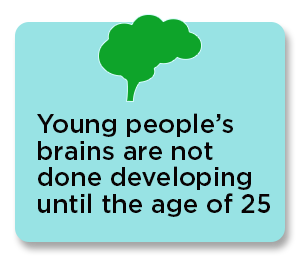 Cannabis can be harmful to growing brains and have long-term health and social impacts. THC in cannabis can affect the developing brain. The part of the brain that is responsible for making decisions (the prefrontal cortex) is one of the last parts of the brain that develops and is particularly impacted by cannabis use.2,5 Young people’s brains are not done developing until the age of 25. Negative cognitive effects can include difficulty thinking and solving problems, problems with memory and learning, reduced coordination, difficulty maintaining attention, and problems with school and social life after consistent consumption.2,5
Cannabis can be harmful to growing brains and have long-term health and social impacts. THC in cannabis can affect the developing brain. The part of the brain that is responsible for making decisions (the prefrontal cortex) is one of the last parts of the brain that develops and is particularly impacted by cannabis use.2,5 Young people’s brains are not done developing until the age of 25. Negative cognitive effects can include difficulty thinking and solving problems, problems with memory and learning, reduced coordination, difficulty maintaining attention, and problems with school and social life after consistent consumption.2,5
TIPS TO KEEP CANNABIS SECURE
If you intend to use cannabis, be sure it is kept in a safe place. Take these steps to help prevent children and pets from accessing cannabis:
- Obtain a lockable storage container to keep your cannabis, INCLUDING cannabis-infused foods and candies.
- Keep cannabis products in a high place, out of reach of children.
- Do not leave cannabis products out when not in use.
- If there are other trusted adults in the house, create a check-in system to ensure cannabis is put away safely.
Cannabis Harms Young Brains: Don’t let youth get high on your supply. Keep it secure.
Driving While Under the Influence of Cannabis is Impaired Driving
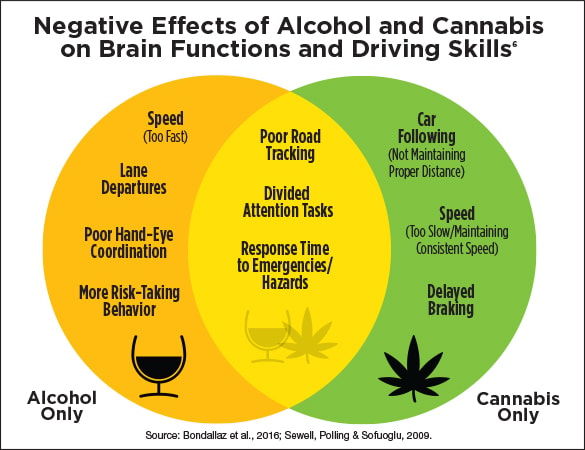
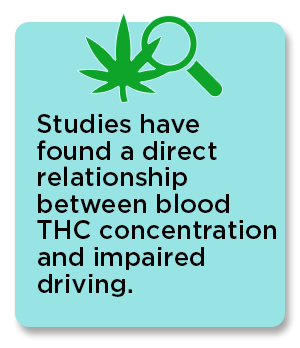 According to the Institute for Traffic Management and Research:
According to the Institute for Traffic Management and Research:
- In 2018 in New York State, there were 314 fatalities for motor vehicle crashes that were related to drugs not including alcohol.7
- In 2020 in New York State, there were 3,931 impaired driving crashes and 27,268 impaired driving arrests.8
Cannabis should always be consumed responsibly, and never before driving or operating heavy machinery.
The rule of thumb is: if you feel different, you will drive different.2
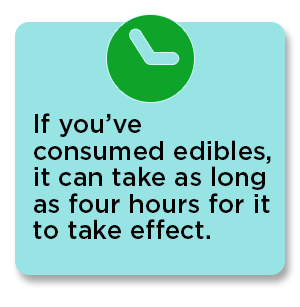 Studies have found a direct relationship between blood THC concentration and impaired driving.9 Often cannabis is combined with alcohol, further increasing the risk of crashes. And remember, if you’ve consumed edibles, it can take as long as four hours for it to take effect. Several sources suggest that following acute use, cannabis consumers should wait a minimum of 3 to 4 hours before attempting to drive (the majority of driving studies have been performed on inhaled cannabis in younger subjects).10 If you’re not sure if you’re high or impaired, stay put, and don’t take the chance of harming yourself or others by driving.
Studies have found a direct relationship between blood THC concentration and impaired driving.9 Often cannabis is combined with alcohol, further increasing the risk of crashes. And remember, if you’ve consumed edibles, it can take as long as four hours for it to take effect. Several sources suggest that following acute use, cannabis consumers should wait a minimum of 3 to 4 hours before attempting to drive (the majority of driving studies have been performed on inhaled cannabis in younger subjects).10 If you’re not sure if you’re high or impaired, stay put, and don’t take the chance of harming yourself or others by driving.
TIPS FOR PREVENTING IMPAIRED DRIVING
If you intend to drive, the safest option is not to use cannabis. Take these steps to help prevent impaired driving if you plan to use, are using or have used cannabis:
- Remain home when you consume cannabis, or plan to stay where you are using for a few hours or overnight.
- Make a plan to get a ride home from someone who has not been drinking alcohol and/or using drugs.
- Decide not to drive and remind your friends and family to do the same if they have consumed cannabis.
- Choose a trusted designated driver who will not use cannabis when you are going out with a group of people you know.
- Use a rideshare service, call a taxi or use another form of public transportation.
Driving High IS Impaired Driving: Don’t drive high. Get a ride.